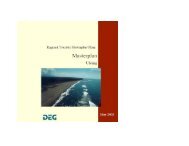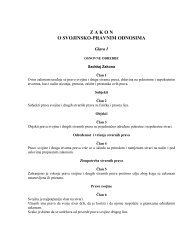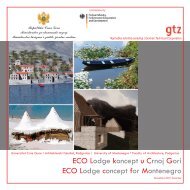Deposit Krute near Ulcinj has reserves <strong>of</strong> A+B+C 1 category <strong>of</strong> about 1,000,000 m 3 andestimated reserves <strong>of</strong> over 5,000,000 m 3 .In fund documentation it is stated that the reserves <strong>of</strong> decorative stone <strong>of</strong> A+B+C 1 category(with smaller part <strong>of</strong> reserves B+C 1 or C 1 ) <strong>of</strong> about 15,000,000 m 3 <strong>of</strong> monoliths, and estimatedat 50,000,000 m 3 .Travertine – Familiar deposits are: Tavani, Zukva, Gornja lijeska and Zbljevo.Tavani (river Bukovica) has proven reserves <strong>of</strong> 275,000 m 3 <strong>of</strong> rock masses, <strong>of</strong> which 116,000m 3 are blocks.Gornja lijeska (west <strong>of</strong> Tomaševo) with reserves <strong>of</strong> C 1 category 94,000 m 3 <strong>of</strong> rock masses andperspective reserves are estimated at 150,000 m 3 .Deposit Zukva is exploited and deposit Zbljevo is not economically significant.Technical-building stone – The amounts <strong>of</strong> technical-building stone in the terrains <strong>of</strong><strong>Montenegro</strong> are practically unlimited. These are carbonates: limestone-dolomite rock massesand smaller volcanic rocks.In the terrains <strong>of</strong> <strong>Montenegro</strong> there are numerous abandoned stone mines. Today, 17 quarries(mines) are operational 12 (twelve) on the Montenegrin coast- Volujica Goran, Velji zabio,Možura – Orlovo, Borik II, Darza, Ristova ponta, Haj-Nehaj, Velja Spilja, Oblatno, Platac,Lješevići – Gajevi, Podi; Midova kosa – Budoš in central region and Kaluñerski laz, Bušnje iŠtitarica in the northern part <strong>of</strong> <strong>Montenegro</strong>. Only in Štitarica (Mojkovac) igneous rocks areexploited while the rest is limestone.Technical-building stone has been researched in 19 locations. The overall reserves <strong>of</strong>carbonate rocks <strong>of</strong> A+B+C 1 or B+C 1 category are 38 million tons, and <strong>of</strong> volcanic rocks only665,000 m 3 .Pebbles and sand – Pebbles and sand are exploited from numerous deposits <strong>of</strong> glacial,fluviglacial, lumniglacial, deluvial and alluvial origin.Sand and pebbles <strong>of</strong> glacial origin are being exploited from a number <strong>of</strong> sites by the roads onkarst surface on the territory <strong>of</strong> municipalities <strong>of</strong> Žabljak, Šavnik and Plužine. Pebbles and sand<strong>of</strong> fluviglacial origin are exploited from fields in karst: Nikšićko, Grahovsko, Dragaljsko etc andfrom Zeta plain, lumniglacial from Bjelopavlici plain. Occasionally, rough sand and pebbles fromcrushers – rock creeps (deluvian) are used along the roads, as for example Nalježići (Kotor).The most significant and mostly used deposits <strong>of</strong> pebbles and sand are <strong>of</strong> alluvial origin: coastalfields (seas) and river beds <strong>of</strong>: Morača, Tara, Lim and Ćehotina.Brick clays – The greatest reserves <strong>of</strong> brick clay are in freshwater neogenic sediments <strong>of</strong>Ćehotina river valley and Lim. Besides these, occurrences and deposits <strong>of</strong> alluvial origin areknown (around Kolašin, Bijelo polje, Spuž, Tivat and Ulcinj). The extent <strong>of</strong> researches is small.In deposits <strong>of</strong> Pljevlja basin reserves <strong>of</strong> B+C 1 and C 1 category count dozens <strong>of</strong> millions <strong>of</strong> tonsand perspective ones <strong>of</strong> several hundred million tons. In deposit <strong>of</strong> Jesikovac reserves B+C 1 are1.3 and perspective ones 2.1 million tons.Deposits <strong>of</strong> brick clays, <strong>of</strong> alluvial origin, <strong>of</strong> B+C 1 and C 1 category are around 15 million tonsand perspective ones are about 5 million tons.Cement marl – Cement marl is found in coal-bearing basins in Ćehotina and Lim river valleysand in parts <strong>of</strong> the terrain built <strong>of</strong> paleogenic flysh sediments: Bjelopavlici, Crmnica onMontenegrin coast (surroundings <strong>of</strong> Ulcinj).The most thoroughly researched and tested marl is from deposit <strong>of</strong> Ćehotina river valley: thesurroundings <strong>of</strong> Pljevlja (Potrlica, Kalušići, Rabitlje, Grevo and Radosavac). Reserves <strong>of</strong>A+B+C 1 category are calculated at 93 million tons, (for 12 years that raw material has beenexploited for Cement <strong>plan</strong>t in Pljevlja which does not work today). In other noted deposits <strong>of</strong>Ćehotina river valley, overall reserves are estimated at 28.3 million <strong>of</strong> tons. Paleogenic reserves<strong>of</strong> marl from Gradina (Bjelopavlici) are around 30 million <strong>of</strong> tons and deposits <strong>of</strong> Donja Kleznanear Ulcinj are estimated at about 20 million <strong>of</strong> tons.25
Dolomites – There are practically unlimited quantities <strong>of</strong> dolomites (limestone dolomite). So farfour (4) localities have been explored: Virpazar, Vranjina (Skadar Lake’s periphery), Šume andBršno (Nikšić surroundings). Total reserves confirmed amount to 88 million <strong>of</strong> tons.Baryta – There is baryta in the area <strong>of</strong> the mountain Kovač. There are well-known deposits inPotkovač and Plana – Arslanovina within down Triassic clastic sediments. Reserves inPotkovač (Guta, Podguta, Bare and Veliki Meljak) <strong>of</strong> A+B+C1 category amount to 309,850 tons.In the Plakola bed there are reserves <strong>of</strong> A+B+C1 categories amounting to 35,000 tons. In themine field Plana-Arslanovina (locations – Rid and Jezero) reserves <strong>of</strong> C1 category amount to11,500 tons. In this area (Kovač) there are some known localities with perspective reservesamounting to around 36,000 tons.Bentonite - Localities and bentonite deposits are known to be present in Bijelo Polje (nearPetrovac on the coast), Brajići (near Budva), in the Bar surroundings, Pivska Župa and inBukovica valley (on the way to Žabljak). Each <strong>of</strong> these localities is <strong>of</strong> medium Triassic age andis the result <strong>of</strong> volcanic activities with disposal into marine environment.The confirmed reserves <strong>of</strong> bentonite deposits in Bijelo Polje <strong>of</strong> A+B+C1 categories amount to1,7 million tons <strong>of</strong> minerals; in the neighbouring deposits in Bijele šume, perspective reservesare estimated to be 1.4 million tons <strong>of</strong> mineral. In the Donja Bukovica deposits there are provenreserves amounting to around 730,000 tons while in the neighbouring locality called Nive theestimated reserves <strong>of</strong> C 2 category amount to 25,000 tons.Localities along the Montenegrin coast and Pivska Župa have not yet been explored.Siliceous earth sand – Siliceous earth sand is present only in Ulcinj surroundings in thefollowing deposits: Zoganje, Škarit and Zekova šuma. Perspective reserves <strong>of</strong> C 2 category inthe Zoganje deposit amount to 3,600,000 tons; in the Škarit deposit – 2,140,000 tons; in theZekova šuma deposit 1,396,000 tons; The total amount <strong>of</strong> reserves is 7,136,000 tonsCherks – Cherks (siliceous sediment rocks) are present in the North-East <strong>of</strong> <strong>Montenegro</strong>(Jurassic diabase layers), on Montenegrin coast (Pindos-cukali zone). So far the cherks havebeen explored in the Vrdola locality (Vrmac near Tivat). Here there are reserves <strong>of</strong> C 1 categoryamounting to 1,210,000 tons.Sea salt – Sea salt (60% <strong>of</strong> chlorine and 40% <strong>of</strong> natrium) is derived from sea water and theprocessing is being done only in the salt factory «Bajo Sekulić» - Ulcinj. The salt is derived bynatural processing (evaporation in basins) and by industrial processing (thermo-compressingprocess). Production with natural processing started in 1935 and with industrial processing in1984. Until the end <strong>of</strong> 2000, 1,355,000 tons <strong>of</strong> sea salt were produced by natural processingand 236,000 tons were produced by industrial processing.Underground-waters – Underground waters are mineral resources. There are static anddynamic reserves: fresh, mineral and thermal waters. No part <strong>of</strong> Montenegrin territory has beenexplored for static reserves as a target area and to a level <strong>of</strong> defining their reserves. Dynamicreserves have been explored and partially defined for certain springs as much as it wasnecessary for providing drinking water for urban centres and for some industrial facilities.Everything that may be said about dynamic (and partially static) reserves <strong>of</strong> underground watersin <strong>Montenegro</strong> is the following:- They participate in total water quantities that flow from Montenegrin territory to the BlackSea basin and to the Adriatic Sea basin. Those quantities are not defined. (Generallyspeaking, in few years 600 m 3 /s <strong>of</strong> water flows away from the territory <strong>of</strong> <strong>Montenegro</strong>);- they are used for drinking water in all municipalities (21), and in a series <strong>of</strong> suburbansettlements, smaller settlements and villages;- they are used in industry (Podgorica Aluminium Factory, Brewery “Niksic” etc) and inwater supply systems in municipal centres;- they are used in agriculture for irrigation (Agro factory “13 jul” in Podgorica etc.)In <strong>Montenegro</strong> 82% <strong>of</strong> the population is supplied with underground-waters through water supplysystems. Only water supply systems in Herceg Novi and in Pljevlja use surface-waters fromBilecko Lake and Otilovici Lake. The remaining 18% <strong>of</strong> the population is supplied with drinkingwater from their own water supply systems, directly from springs or from cisterns. Around 40%<strong>of</strong> village population does not have regular or good quality drinking water .26
- Page 1 and 2: SPATIAL PLAN OF MONTENEGROUNTIL 202
- Page 3 and 4: Ljubiša Kuzović, Traffic Engineer
- Page 5 and 6: Representatives of the Sector for S
- Page 7 and 8: Zlatko Bulić, MANatural and Landsc
- Page 9 and 10: 3.2.8 Flora and fauna as developmen
- Page 11 and 12: 1.5 Position and directions of deve
- Page 13 and 14: 4.3.2 Provision of studies required
- Page 15 and 16: This definition is widely in compli
- Page 17 and 18: General principle:Sector principle:
- Page 19 and 20: A - APPRAISAL OF THE STATE OF THE S
- Page 21 and 22: een developed as the centre of nati
- Page 23 and 24: Hunting - Sustainable forest manage
- Page 25 and 26: 1.5 Seismic risk and risk from othe
- Page 27 and 28: 2 EXPERIENCES FROM THE PLANNING PRO
- Page 29 and 30: General urban plans are elaborated
- Page 31 and 32: The tendency of the construction in
- Page 33: 3. MAIN FACTORS OF SPATIAL DEVELOPM
- Page 36 and 37: 3.2.2. Mineral raw materialsWith th
- Page 40 and 41: Underground-waters are used in indu
- Page 42 and 43: Picture 3. A card of seismic hazard
- Page 44 and 45: climate conditions are suitable for
- Page 46: 3.2.9 Landscape valuesVariety of la
- Page 58 and 59: 3.3 Population3.3.1 Population of M
- Page 60 and 61: As for the economic structure of th
- Page 62: Changes of town structures - In som
- Page 65 and 66: Rural areas are characterised by lo
- Page 67 and 68: 403530252015Share of the industry i
- Page 69 and 70: Forests and forest land in Monteneg
- Page 71 and 72: 3 municipality Šavnik 57 0 57 1 1.
- Page 73 and 74: Herceg Novi etc.) and suburban sett
- Page 75 and 76: Spatial distribution of the activit
- Page 77 and 78: The railway network also includes m
- Page 80 and 81: In the current legal framework the
- Page 82 and 83: operational under 35 kV voltages. I
- Page 84 and 85: 3.7.3.2 Use of water for water supp
- Page 86 and 87: Excess water of diverse origin puts
- Page 88 and 89:
Appropriate information, knowledge
- Page 90 and 91:
The existing nationally protected a
- Page 92 and 93:
Cetinje 10 22 23 I2 21 23 2 - - 425
- Page 94 and 95:
marinas and shipyards) for acceptan
- Page 96 and 97:
- Danger for the river Tara from un
- Page 98 and 99:
3.10.4 Problems of harmonisation of
- Page 100 and 101:
Outflow of communal and industrial
- Page 102 and 103:
Changes of proprietary relations -
- Page 104 and 105:
1. BASIC POSTULATES OF THE SPATIAL
- Page 106 and 107:
1.3.1 Global development principles
- Page 108 and 109:
7. Providing communal equipment of
- Page 110 and 111:
O1.3.2.1-6 Exploration of oil and g
- Page 112 and 113:
O1.3.2.1-17 In protected or planned
- Page 114 and 115:
O. 1.2.3.4.5. New objects for scien
- Page 116 and 117:
Traffic infrastructureObjectives:O1
- Page 118 and 119:
P1.3.2.3-8P1.3.2.3-9Adequate combin
- Page 120 and 121:
infrastructure has to be reduced to
- Page 122 and 123:
other technical and technological a
- Page 124 and 125:
O1.3.3.1-8 Settlements are planned
- Page 126 and 127:
P1.3.3.2-3P1.3.3.2-4P1.3.3.2-5P1.3.
- Page 128 and 129:
Explanation: “Adequate distances
- Page 130 and 131:
Of particular importance is the mor
- Page 132 and 133:
Objectives:O2.1-1Development corrid
- Page 134 and 135:
B. Polje 50,284 15,883 56,166 34,02
- Page 136 and 137:
fertile age. Projection is based on
- Page 138 and 139:
7. Spuž in Danilovgrad8. Sutomore
- Page 140 and 141:
2.3.3 Urban and construction identi
- Page 142 and 143:
19. Zabljak - construction stone an
- Page 144 and 145:
particular areas. This also include
- Page 146 and 147:
linking with services required by b
- Page 148 and 149:
and Mrtvica, and which eventually w
- Page 150 and 151:
2.5.6 Spatial development concept o
- Page 152 and 153:
RoadMarkFROM - TOSUGGESTION FOR CHA
- Page 154 and 155:
For the development of port facilit
- Page 156 and 157:
2. Užice - Prijepolje - Podgorica
- Page 158 and 159:
O2.6.4-2O2.6.4-3For inter-municipal
- Page 160 and 161:
O2.6.4-11Explanation: Concrete dete
- Page 162 and 163:
Explanation: Although the existing
- Page 164 and 165:
The well known bio-corridor of cost
- Page 166 and 167:
2.12 Bases of protection of interes
- Page 168 and 169:
3 GUIDELINES AND MEASURES FOR REALI
- Page 170 and 171:
3.3 Guidelines for the land use and
- Page 172 and 173:
3.4.2. Development zones of the Coa
- Page 174 and 175:
wide scale conflict between the gen
- Page 176 and 177:
traffic network. That very limited
- Page 178 and 179:
Thresholds: The existing sources fo
- Page 180 and 181:
Conflicts: Generally speaking - thi
- Page 182 and 183:
Control of seismic risk, technical
- Page 184 and 185:
pollution; providing adequate dispo
- Page 186 and 187:
Cetinje, by construction of planned
- Page 188 and 189:
Thresholds: Further urban developme
- Page 190 and 191:
Thresholds: Very limited accessibil
- Page 192 and 193:
Sub-zone BIJELO POLJECovers the low
- Page 194 and 195:
Limitations: Limitation of developm
- Page 196 and 197:
accent on reconstruction and cultiv
- Page 198 and 199:
waterpower sector (regulating relat
- Page 200 and 201:
- Ensuring quality of ground and un
- Page 202 and 203:
land cultivation and revitalization
- Page 204 and 205:
Processes in scope of this subsyste
- Page 206 and 207:
inter-ministries harmonization of t
- Page 208 and 209:
- Prepares decisions on starting th
- Page 210 and 211:
- Research of intellectual capital
- Page 212 and 213:
C132.000 t16. Barite A+B+C1 344,85
- Page 214 and 215:
3 Budva 12200 4959 40.65 1050 6815
- Page 216 and 217:
14 Andrijevica 28300 181 0.64 0.18
- Page 218 and 219:
Sources/LiteratureSources of genera







